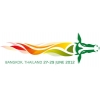Calendar
FAO/OIE global conference on Food and Mouth Disease control


The first global conference on FMD, ’The way towards global FMD control’, was organized by OIE and FAO in Asuncion, Paraguay in June 2009. The participants of the Conference formulated a set of recommendations and reiterated their strong support for a globally coordinated approach to FMD control. Recommendation 14 called for a pledging conference with the participation of free and affected countries, relevant organizations and donors, to support a global FMD-control programme.
Under the umbrella of the Global Framework for the Control of Transboundary Animal Diseases (GF-TADs), FAO and OIE jointly prepared a draft Global FMD Control Strategy. The strategy will be finalized during 2012 with the participation of relevant regional organizations and experts. The Progressive Control Pathway (PCP) for FMD developed by FAO and OIE, and the Performance of Veterinary Services (PVS) Pathway provided by OIE, are important tools to build and implement the Global FMD Control Strategy. The overall objective of the Global Strategy is to improve animal production and marketing in developing countries and thereby alleviate poverty, increase income generation and improve the livelihoods of small farmers and add to human well being.
The specific objective of the Global Strategy is to decrease the impact of FMD world-wide by reducing the number of outbreaks of the disease and improving animal health. This will require the strengthening of national Veterinary Services and the related infrastructure, including the laboratories, the public-private partnerships and the involvement of the industry. The strengthening of the Veterinary Services and the veterinary infrastructures will, in turn, improve a country’s capability to prevent and control other transboundary diseases and make the progress achieved more sustainable.
Lessons learned from regions with advanced FMD control programmes are incorporated. As demonstrated in several countries and regions, it is possible to control the spread of FMD and, under certain circumstances, to eradicate the disease. Important components of a successful strategy have been identified, including effective national Veterinary Services, competent diagnostic laboratories, quality-controlled vaccines matching the virus strains prevailing in the region, well-designed epidemio-surveillance systems and well-functioning private-public partnerships. The efforts at national level should be supported and coordinated at regional and global level and backed up by continuous research programmes.
In addition to the core objective of decreasing the impact of FMD, the global FMD control strategy includes two additional objectives, namely:
the strengthening of the Veterinary Services and
the improvement of other (transboundary) animal disease control activities..
Experience has shown that better control of FMD requires improved capabilities and infrastructure of national Veterinary Services. Achieving this will improve a country’s capability to prevent and control other (transboundary) animal diseases.
By combining FMD control activities with those of other disease control programmes, economy of scale advantages may be obtained and incentives for owners may be created. Such combinations of disease control activities should be fine-tuned to the regional needs.
Therefore the overall aim of the Global FMD control Strategy is to reduce the global impact of FMD, but in addition to use the FMD control programme as an entry point to achieve sustainable progress in veterinary systems and spin-off effects in other disease control areas
